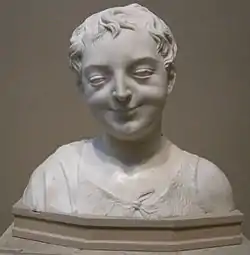Master of the Marble Madonnas
The Master of the Marble Madonnas was the name given to an unidentified sculptor, or perhaps group of sculptors, active in the Tuscan region of Italy between c. 1470 and c.1500.[1] He is thought to have been responsible for a group of stylistically related sculptures that is based mainly on their related compositions and drapery forms. Products of the Master's workshop include a large number of reliefs of the Virgin and Child; busts and reliefs depicting the suffering of Christ were also popular, as were busts of children. Various mannerisms can be seen in this group, as well; among these has been what is described as "a peculiar feline smile from heavy-lidded eyes and a taut jaw, at its best radiating inward joy but often acerbic or bordering on the manic[2]"

The name "Master of the Marble Madonnas" was coined by Wilhelm von Bode in 1886, who noted several points of similarity linking these sculptures to the production of well-known Florentine masters such as Mino da Fiesole, Antonio Rossellino, Desiderio da Settignano, and Benedetto da Maiano but which are generally inferior in quality and execution. Under whom this "Master of the Marble Madonnas" might have received his training is unknown but it surely would have been in the workshop of one of these masters. Previous attempts to identify van Bode's Master of the Marble Madonnas with either Giovanni Ricci, Domenico Rosselli, or Tommaso Fiamberti did not gain wide acceptance.[3] Fiamberti's name did receive the most critical support.[4]
In 2001, Alfredo Bellandi presented evidence connecting the Master of the Marble Madonnas and the sculptures associated with that name to a rather obscure Florentine sculptor named Gregorio di Lorenzo.[5] Gregorio was trained in the workshop of Desiderio da Settignano, absorbing through him characteristics common to the Rossellino brothers. As an independent master, Gregorio di Lorenzo is documented in Florence from 1455 to 1495.[6]
Gregorio di Lorenzo is known also to have worked in the ducal courts of Urbino and Ferrara, also making trips to Hungary to serve Mattia Corvino and to Italian outposts along the eastern Adriatic. His significance to the Italian Renaissance lies not so much in any particular work but in the overall contribution he rendered in spreading the Florentine approach to sculpture to a wider audience.
Works by the Master can be found in various museum collections, including those of the Pinacoteca Civica, in Forlì (Italy); Columbia Museum of Art in Columbia, SC;[7]National Gallery of Canada in Ottawa; National Gallery of Art in Washington, D.C.;[8] the National Gallery of Australia;[9] and the Louvre.[3] The Washington collection also contains a nineteenth-century work copying his style.[10]
References
- This entry is based largely upon that of James Peck and Charles Mack in Charles R. Mack,European Art in the Columbia Museum of Art including the Samuel H. Kress Collection. Volume I, the Thirteenth through the Sixteenth Century, University of South Carolina Press, Columbia 2009, 116-20
- Answers.com
- La Vierge et l'Enfant entre deux anges. (in French)
- Giacomo de Nicola, "Tommaso Fiamberti: il Maestro delle Madonne di Marmo, Rassegna 'Arte, 9,73,78
- Alfredo Belandi, "Master of the Marble Madonnas," in Masterpieces of Renaissance Ar: Eight Rediscoveries, edited by A. Butterfield and A. Radcliffe, New York: Salander O'Reilly Gallery, 2001,34-40
- Silvia Blasio (a cura di), Marche e Toscana, terre di grandi maestri tra Quattro e Seicento, Pacini Editore per Banca Toscana, Firenze 2007.
- Charles R. Mack,European Art in the Columbia Museum of Art including the Samuel H. Kress Collection. Volume I, the Thirteenth through the Sixteenth Century, University of South Carolina Press, Columbia 2009, 116-20
- Master of the Marble Madonnas at NGA.gov
- Madonna and Child of c. 1480
- Madonna and Child, c. 1860/1900
| Wikimedia Commons has media related to Gregorio di Lorenzo. |